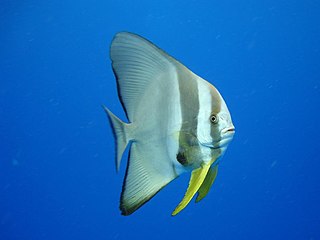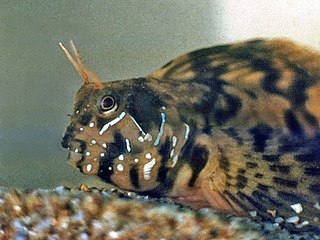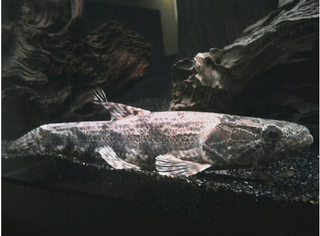
Achille Valenciennes was a French zoologist.

Auguste Henri André Duméril was a French zoologist. His father, André Marie Constant Duméril (1774-1860), was also a zoologist. In 1869 he was elected as a member of the Académie des sciences.

Pseudoplatystoma tigrinum, the tiger sorubim or caparari is a species of long-whiskered catfish native to the Amazon Basin in South America.

Platax is a genus of Indo-Pacific, reef-associated fish belonging to the family Ephippidae. There are currently five known extant species generally accepted to belong to the genus. They are one of the fish taxa commonly known as "batfish".
Jacques Pellegrin was a French zoologist.

The saucereye porgy is an ocean-going species of fish in the family Sparidae. In Bermuda, they are also known as the goat's head porgy. In Jamaica, they are known as the Porgi grunt and the sugareye porgy. They may also be known simply by the name Porgy in several other Caribbean islands. Saucereye porgies are considered to be minor gamefishes and when caught are marketed both fresh and frozen.

The sphinx blenny is a species of combtooth blenny, and the only species in the genus Aidablennius. It was described by Achille Valenciennes in 1836, originally under the genus Blennius, and was later reassigned under "Aidablennius" by Gilbert Percy Whitley in 1947. It is a subtropical blenny known from Morocco, in the eastern Atlantic Ocean, and also from the Mediterranean and Black Seas. Sphinx blennies inhabit shallow, rocky waters in the littoral zone, with sunlight exposure. They feed primarily on benthic algae, weeds and invertebrates. Sphinx blennies can measure up to 8 centimetres (3.1 in) long in total length.

Hoplias aimara, also known as anjumara, traira, trahira, manjuma, anjoemara and wolf fish, is a species of freshwater fish found in the rivers of South America. In Amazonia, the native populations are concerned by high levels of mercury contamination which has been linked to the consumption of contaminated fish. H. aimara is a good bioindicator of such contamination.

Hoplias is a genus of fish in the family Erythrinidae found in Central and South America.

Hoplias australis is a predatory freshwater characin fish of the southern Neotropics.
Hoplias brasiliensis is a species of trahiras. It is a benthopelagic, tropical freshwater fish which is known from coastal rivers in northeastern Brazil, including the Paraguaçu River in Bahia, the Pardo River, the Jequitinhonha River in Minas Gerais and Espírito Santo, and the Contas River. Male H. brasiliensis can reach a maximum length of 20.3 centimetres.
Hoplias lacerdae is a predatory freshwater characin fish from South America. The are commonly known are trairão in Brazilian Portuguese.
Hoplias microcephalus is a species of trahiras. It is a tropical, benthopelagic freshwater fish which is known to inhabit the São Francisco River in Brazil. Males can reach a maximum length of 35.6 centimetres.
Hoplias patana is a species of trahiras. It is a freshwater fish which is known from Cayenne, French Guiana. The maximum length recorded for this species is 39.4 centimetres.
Albula argentea, the silver sharpjaw bonefish, is a species of marine fish found in the tropical western Pacific Ocean. They grow up to 70 cm (28 in).

The shovelnose sea catfish, also called the short-nosed catfish or the marine catfish, is a species of sea catfish in the family Ariidae. It was described by Achille Valenciennes in 1840. It is a non-migratory species which inhabits tropical marine and brackish waters in the Indo-western Pacific region, including Indonesia, India, Pakistan, the Philippines and Thailand. It dwells at a depth range of 0 to 20 m. It reaches a maximum NG length of 39.5 cm (15.6 in), while commonly reaching a total length of 12 cm (4.7 in).

The veined catfish, also known as the marine catfish, is a species of sea catfish in the family Ariidae. It was described by Achille Valenciennes in 1840. It inhabits tropical marine and brackish waters in the Indo-western Pacific region, including the Mozambique Channel, Myanmar, Indonesia and southern China. It dwells at a depth range of 20 to 50 m. It reaches a maximum total length of 30 cm (12 in), but more commonly reaches a TL of 19 cm (7.5 in).
The Bressou sea catfish, also called the marine catfish, is a species of sea catfish in the family Ariidae. It was described by Achille Valenciennes in 1840, originally under the genus Arius. It inhabits tropical marine, brackish and freshwater on the Atlantic coast of South America, ranging from Guyana to Brazil. It reaches a maximum total length of 50 cm (20 in), but more commonly reaches a TL of 30 cm (12 in).
Kuhila malo is a freshwater and brackish water species of ray-finned fish from the family Kuhliidae which is endemic to French Polynesia.
François-Étienne de La Roche was a Genevan physician, naturalist, chemist, botanist and ichthyologist.










